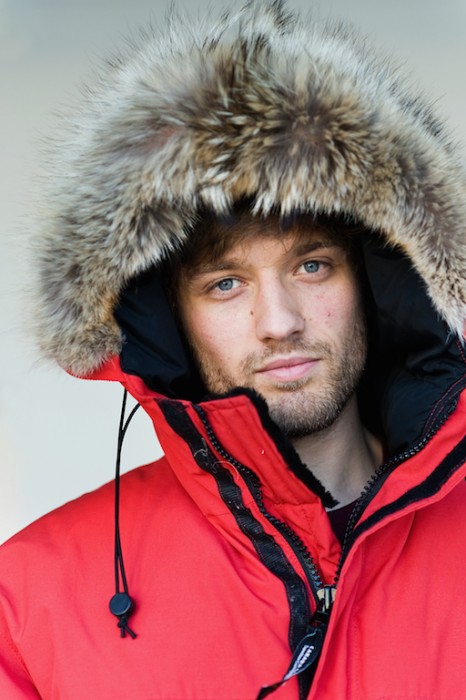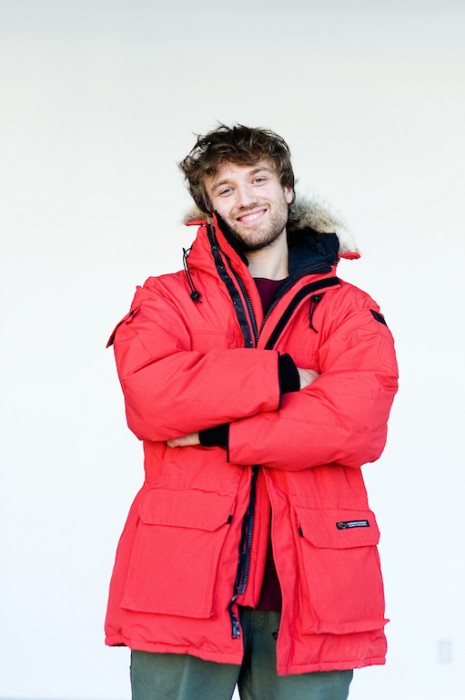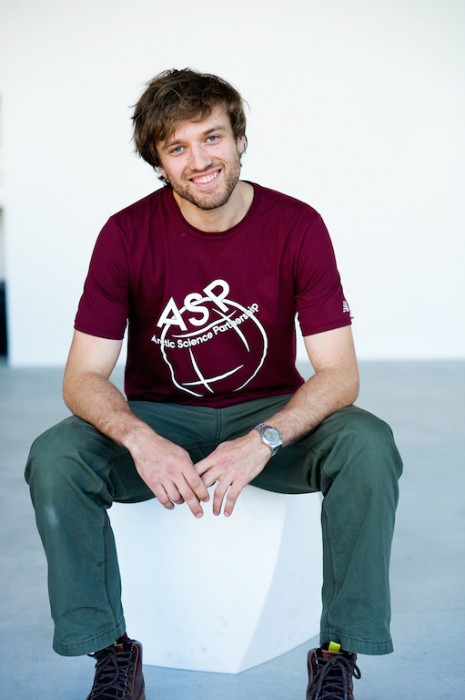
Wieter Boone / Image: Katie Chalmers-Brooks
CANDID: Q&A with grad student Wieter Boone
Roughly 3,800 students are enrolled in the University of Manitoba’s Faculty of Graduate Studies. They come from around the world to study here and UM Today is getting to know some of them on a more personal, candid, level. We want to know who they are, why they chose the field they did, and about their hobbies, regrets and musical tastes.
Candid is our new bi-weekly feature that will bring these remarkable individuals to the fore. Enjoy!
PhD student: Wieter Boone
Studying in: Clayton H. Riddell Faculty of Environment, Earth, and Resources
Advisor: Søren Rysgaard, Canada Excellence Research Chair
UMT: Where are you from?
WB: I’m from Belgium
UMT: What made you want to come here?
WB: The program. I really wanted to work in the Arctic, and I thought that working within the Arctic Science Partnership (ASP) was a great opportunity. The partnership between CEOS, the Greenland Climate Research Centre and the Arctic Research Centre of Denmark is a great environment to do research and to develop as a person.
UMT: You heard about them and wanted to come here?
WB: Yeah, they posted a position on APECS, a network for polar scientists. I always knew I wanted to do something in that area after my masters, but I was just waiting to find the right job posting.
I studied engineering back in Belgium – environmental engineering – and I took courses in the Maritime Academy as well, navigation, safety courses and advanced medical first aid training that kind of stuff, just to be ready for field campaigns. For the medical first aid training I did a two week internship in the emergency department of a hospital. It was challenging but very interesting.
UMT: So you knew you wanted to do sea ice research?
WB: Yeah, I was attracted by the science, the extreme environment and the challenges you have working in the field. That is something I always wanted to experience.
I have always been fascinated with water because I have been sailing since I was a kid. I really like sailing.
That fascination led me, during my master’s, to Quebec City, where I studied the impact of the ice on tidal flats on the hydrodynamics of the navigation channel. So back there, I got involved in ice work and modelling. When I went back to Belgium, I worked as a hydraulic engineer for a consulting company.
I never really forgot my fascination for ice. Hydraulics is one thing, but when ice comes into play it’s soooo much more interesting. There’s this extra variable. There’s so much more going on. It’s really interesting.
So that is really what got me back into ice and ice dynamics. I began reading up on it and got prepared, and when I saw the posting I said:‘Okay, let’s go for it!’
The job posting came up in February and I started in September – that was last year.
UMT: What did you think of Winnipeg when you first arrived?
WB: I did not know what to expect. I actually never heard about the city, but now, after living here for a year, I like it. It’s fun. I like that you don’t have to go far to get out in the wild and into nature. The provincial parks are great; we have been to most already. For winter camping. Stuff like that.
UMT: Do you miss Belgium?
WB: I miss my family for sure.
UMT: Do you miss anything in particular about home?
WB: No, not really. We do take a stash of chocolate every time we go back home, to share when we have guests and to soothe us when we are homesick.
UMT: Do we have any weird customs here?
WB: During our first visit to Manitoba we were surprised about the many small conversations people have in shops, on the bus, everywhere. People in Belgium don’t talk as much to people they don’t really know, but actually I like it better in the Manitoban way.
UMT: In a nutshell, what do you study?
WB: Well, I study the biogeochemical interactions between sea ice and the ocean and its role in the arctic carbon cycle and thus in our climate. I can just quickly try to explain what it is about.
When sea ice starts growing from sea water it produces cold and salty water that is called sea ice brine. It plays an important role in the vertical transport between the atmosphere, the ice and the ocean. In the sea ice little carbonate precipitates form what releases CO2. That CO2 dissolves in the liquid brine inclusions in the sea ice and some of it is transported to the ocean. The process carries thus CO2 away from the surface and prevents exchange with the atmosphere above the ice and is an important process in the Arctic carbon cycle. To understand these processes better we need to know the fate of the released brine from sea ice to the underlying ocean and that is where I come in. I have to find out where the brine goes?
UMT: What is it that fascinated you about this field?
WB: What fascinated me? Besides the science, I think the challenges of the fieldwork. That’s something that really fascinated me.
And climate change —the global importance of it. You are not studying something you don’t really know the use of. Climate change, and the whole carbon cycle, is just something really important to understand. Although it’s a very small part of the cycle I study now, it’s part of a more general and more relevant whole that you can directly link to a phenomenon of global importance.
UMT: What did you want to be as a kid?
WB: I don’t remember. When I started studying I thought I’d be a doctor or an engineer. But then I decided to go for the more practical studies I think.
“… we will be one of the first scientists ever doing work on the ice and in the ocean over there.’
UMT: Did you always think you had a scientific mind?
WB: I grew up with three older sisters and they kind of guided me through the world. I always heard the new things they learned in science classes from them—one of my sisters would always show me her book and ask, ‘Do you know why that is?’
My parents were both teachers and I think they, well, my dad really likes to talk about and explain everything he sees—this is that, and that is like this because of that, … Especially when we were travelling.
So now I think about it, I learned to be curious and explore new terrain while travelling all over Europe with my family in our nineties RV that my dad built himself. I think travelling and my curiosity made me want to explore more and more and then the Arctic was…like the ultimate unknown for me.
This year we go to Station Nord, a field station in northern Greenland, we will be one of the first scientists ever doing work on the ice and in the ocean over there. That’s really crazy. I’m telling you this now and I’m getting goose bumps already.
UMT: When was your first trip to the Arctic?
WB: Last year. My first trip to Nuuk in Greenland was in September of last year.
UMT: How did it make you feel?
WB: I feel small when I’m in the Arctic. You’re so alone in such a big, vast area. When we were in Young Sound, in the Northeast Greenland National park, you’re just there with the elements. Nothing can go wrong because there is nobody there to help you out. You have to be with very experienced people like Søren and Kunuk, and still, even when you know they will help you out, you have to be very careful anyhow. You have to think twice before you do something because if you break your leg, you’re a long way from a doctor and a very long way from home.
UMT: Do you play music in the lab?
WB: I mostly listen to Belgian radio when I have to do analysis.
UMT: Do you have any hobbies?
WB: Here, in summer I like to go out with a canoe. I was teaming up with an ultimate Frisbee team last summer and I am in a curling team this winter. I like to go winter camping and do other winter activities, like skating and cross country skiing. What else? I like the restaurants here in Winnipeg and the atmosphere in the diners outside the city.
UMT: What is the best part of your job here?
WB: The opportunities. The fieldwork. And the people. I like working with the ASP team and with Søren. He’s a really nice guy even beside the science – he’s so busy but he still makes time to be a person. He’s not just an email address you communicate with. When he’s here he’s really present. He makes time to come to our home to have dinner or he will send a text to have a beer together. Stuff like that. It’s really nice to work with him.
And my other advisor Igor is also really enjoyable. Actually, just because you are together in the field – I was in Greenland with Søren and Igor [Dmitrenko]– you get another bond then with someone you only see in the office. It’s more personal, we have to cook for each other. So, for example, we’re making bread and you are thinking, ‘Oh, he makes nice bread’ or ‘Oh, he does something funny every morning.’ You get to know each other better, and in a different way than just the academic way. It’s really nice.
UMT: Who’s the best cook in the field?
WB: We adapted a custom of the Danish Sirius Patrol: if you complain about the food or if you make too much sarcastic jokes about how ‘good’ the food is, you have to bake a cake for everybody. So my answer in the field would be: everybody is a good cook! But if I look back, Odile makes the best cakes and desserts, Søren’s roast is just perfect and Ryan and Dave always came up with special recipes to prepare chicken.
UMT: What’s the most memorable advice you have received in your academic career?
WB: Just try it. That’s what Søren said to me a couple of minutes ago, ‘Just try it.’
Research at the University of Manitoba is partially supported by funding from the Government of Canada Research Support Fund.









